
Apocynaceae is a family of flowering plants that includes trees, shrubs, herbs, stem succulents, and vines, commonly known as the dogbane family, because some taxa were used as dog poison. Members of the family are native to the European, Asian, African, Australian, and American tropics or subtropics, with some temperate members. The former family Asclepiadaceae is considered a subfamily of Apocynaceae and contains 348 genera. A list of Apocynaceae genera may be found here.

Pachypodium is a genus of succulent spine-bearing trees and shrubs, native to Madagascar and Africa. It belongs to the family Apocynaceae.

Pachypodium lealii, the bottle tree, is a species of plant included in the genusPachypodium. The scientific name derives from the 19th century Portuguese geologist Fernando da Costa Leal, who described the bottle tree during an exploration in southern Angola.
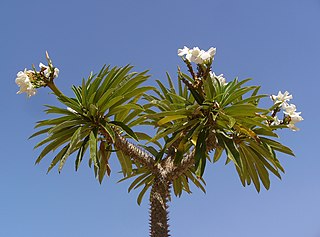
Pachypodium lamerei is a species of flowering plant in the family Apocynaceae. It is a stem succulent, photosynthesizing mainly through its trunk, and comes from the island of Madagascar, off the east coast of Africa. It has large thorns and leaves mostly just at the top of the plant, and large, fragrant flowers. The species has become one of the best known pachypodiums in cultivation, being relatively easy to propagate and grow. In cultivation it is often marketed as the Madagascar palm, despite its not being a palm at all. A variety called "Ramosum" has been described. It is distinguished mostly by a dwarf growth habit and its more rounded corolla lobe.
The taxonomy of the Pachypodium genus is the study of the species and subspecies in the genus Pachypodium. There are currently 25 recognized species in the genus, of which 17 are shrubs and eight are trees.

Pachypodium ambongense is a species of plant in the family Apocynaceae. It was first published as a species of the genus Pachypodium in 1924 by the botanist Henri Louis Poisson.

Pachypodium baronii, the Madagascar palm or bontaka, is a flowering plant in the family Apocynaceae. It has the habit of a robust shrub with a spherical or bottle-shaped trunk. It has several cylindrical branches at the top.
Pachypodium bicolor is a species of plant in the family Apocynaceae.
Pachypodiumhabitats consist of isolated, specialized, micro–environmental niches, generally xeric, rocky, frost-free areas within parts of western Madagascar and southern Africa. Pachypodium species are often indifferent to the regional ecological, biotic zone of vegetation, a fact which explains some of Pachypodium morphology and architecture. The large scale vegetation zones are in some cases irrelevant to the micro-environments of Pachypodium, in the sense that the xeric niches may be embedded in larger mesic biomes.

Pachypodium brevicaule is a species of plant that belongs to the family Apocynaceae.

Pachypodium geayi is a species of Pachypodium that originated from Southwest Madagascar. It has a metallic grey pachycaul trunk and the leaves are thin and grey-green, with a bright pink mid-rib. The plant has white flowers. Pachypodium geayi is one of the largest of the Madagascar species.

Pachycauls are plants with a disproportionately thick trunk, for their height, and relatively few branches. With certain pachycaul species, particularly the more succulent varieties, they are commonly referred to as "caudiciformes", a reference to their trunk development of a moisture-filled caudex for periods of drought.
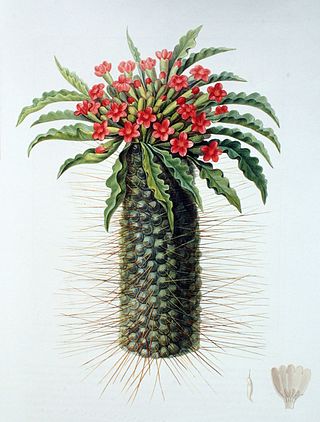
Pachypodium namaquanum, also known as halfmens or elephants trunk, is a succulent plant of Southern Africa. The genus name Pachypodium is from the Greek for 'thick foot', an allusion to its swollen base, while the species name namaquanum is a reference to Namaqualand.
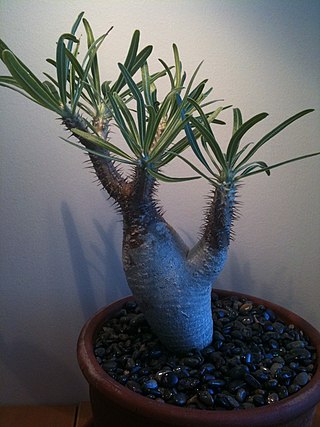
Pachypodium gracilius is a species of Pachypodium endemic to Madagascar. The plant trunk is pachycaul, and typically short and fat. It produces yellow flowers.

Uncarina is a genus of semi-succulent flowering plants in the Pedaliaceae found in Madagascar. As most species within the genus are inhabitants of dry, semi-arid or seasonally-dry regions, many mature into water-storing pachycauls, or "caudiciformes"—a common colloquial term to describe plants that normally inhabit drier climates and develop a large, woody base, or "foot", known as a caudex. In these species, a plant's lower half gradually accumulates and stores water ; over time, the caudex changes shape, swelling to an often impressive size, as it adds to its own moisture "reservoir" for future periods of drought. In addition to Uncarina, many other caudex-forming genera can be found on Madagascar as well as beyond, such as Adenium, Beaucarnea, Dioscorea, Euphorbia, Gerrardanthus, Pachypodium and Stephania, among others.

Pachypodium rosulatum, common name elephant's foot plant, belongs to the family Apocynaceae.
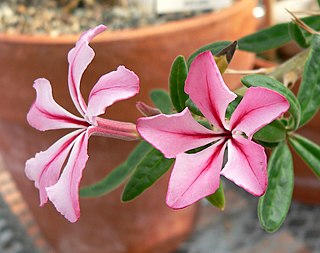
Pachypodium succulentum is a member of the family Apocynaceae native to the Cape Provinces and the Free State province of South Africa.

Pachypodium bispinosum is a succulent sub-shrub in the family Apocynaceae.

Pachypodium decaryi is a flowering plant, and a member of the family Apocynaceae. This species was first described in 1922 by Henri Louis Poisson. It is native to central Madagascar, growing on bare rocks with little water and a lot of sunlight. The caudex of this species can grow to 40 centimetres in diameter, and the taller stems can grow up to three or four meters. It blooms with white flowers.
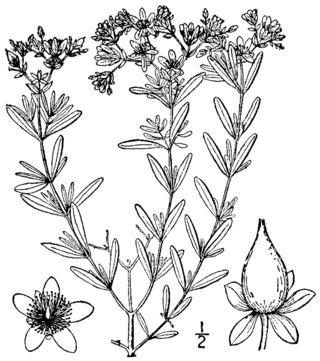
Hypericum densiflorum, also known as bushy St. John's wort or dense St. John's wort, is a perennial herb in the flowering plant family Hypericaceae native to North America. The specific epithet densiflorum is Latin, meaning "densely flowered", referring to the many-flowered cymes.


















